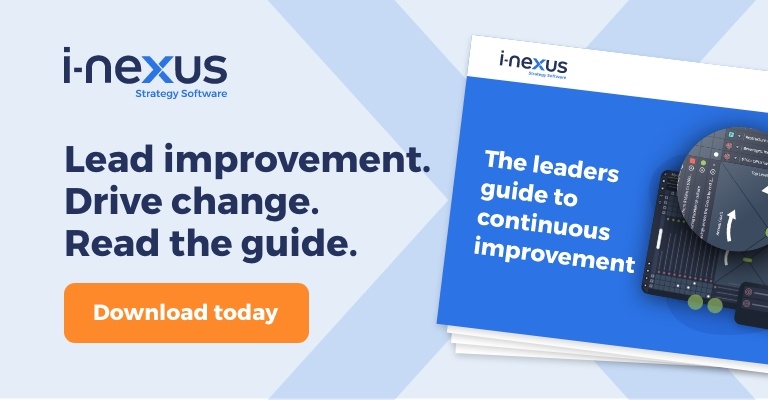Get to know how Kaizen is used in businesses worldwide to drive strategic value from daily work and how you can implement it in your organization.
Meaning ‘continuous improvement’ in Japanese, Kaizen is a business philosophy that focuses on improving processes and operations and involving employees from all levels of an organization.
Kaizen focuses on the power of small, gradual, positive changes in the workplace. A business can improve employee and customer satisfaction through Kaizen, reduce waste, and boost productivity.
In this guide, we will explain how Kaizen is used in business to give you an idea of whether or not this philosophy might be helpful to you.
Jump to the section you want
Read on or click below to jump to the part of Kaizen you want to learn about:
- What is Kaizen?
- The five elements of Kaizen
- Employees and Kaizen ideas
- The benefits of Kaizen
- The challenges of Kaizen
- Standard work and Kaizen
- Value stream mapping and Kaizen
- How to implement Kaizen
- Putting in place plans for continuous improvement
- Examples of implementing Kaizen
- Kaizen books to read
What is the Kaizen method?
Introduced in Masaaki Imai’s Kaizen: The Key to Japan’s Competitive Success, Kaizen is often applied by manufacturers; the most well-known example is Toyota.
It is also popular among the tech and healthcare industries and service improvement. It has even been adapted for life coaching and personal development.
Imai writes:
"the method of the Kaizen strategy is that not a day should go by without some kind of improvement being made somewhere in the company".
Kaizen involves its principles being a fully integrated part of a company’s culture.
More of a methodology than a business model, the Kaizen approach can work well alongside lots of other management tools and strategies.
Changes made through Kaizen may seem small to those seeking more obvious instant gratification, but they aim to contribute towards tremendous change in the long run.
The five elements of Kaizen
1. Teamwork - fostering an environment that encourages teamwork and involves everyone in upholding Kaizen2. Personal discipline - adherence to standardized processes and procedures in the name of efficiency
3. Improved morale - due to direct involvement in problem-solving, employees feel that they can make an impact in their workplace, have greater engagement levels, and have higher morale
4. Quality circles - where workers with similar roles meet regularly to identify problems within their working processes and think of solutions together
5. Suggestions for improvement - ensuring that all employees feel empowered to admit mistakes and suggest improvements
With these principles in place in your organization’s culture, you can fully benefit from the Kaizen approach to making changes:
- A problem or area that could be improved is identified, and a goal is set
- Employees explore new ideas and possible solutions
- The goal is broken down into achievable or sub-objectives
- To make sure that no one’s tasks overlap and that no one is stretched too thinly, tasks are assigned to tackle each sub-objective
- Changes are implemented, and the results monitored
- If your changes provide the desired results, they are adopted permanently.
One of the methods used alongside Kaizen and by Lean practitioners in general to identify problems is the 5s framework.
This framework prioritizes standardization to see areas in need of improvement better. The 5Ses and their English translations are:
- Seiri (sort) - remove unnecessary things from the workplace
- Seiton (set in order) - organize what remains for ease of use
- Seiso (shine) - keep your workspace clean and tidy
- Seiketsu (standardize) - systemize how to keep things clean/running smoothly
- Shitsuke (sustain) - keep up this practice until it becomes an ingrained habit
This system is tailored towards Lean production but can easily be interpreted and adapted for many organizations and personal use.
5S floor markings in a manufacturing site
Manufacturing 5s floor markings are essential to efficiently organizing a manufacturing process and improving safety.
5s floor markings are used to standardize the layout of the workplace, visually communicate company values and goals, remind people about standard operating procedures, and provide guidance to employees in a consistent format.
Floor markings are one of the ways that 5s is implemented in a manufacturing setting.
Markings can be created through painting or tape, making it easy for employees to quickly identify what needs to be done, where tools should be stored, where hazardous materials are located, etc.
They also guide how processes should be performed safely and correctly.
Floor markings can also help indicate vehicle routes, workstations, assembly lines, safe walking paths etc. This cuts down on confusion related to processes which save time and help improve safety.
Manufacturing 5s floor marking helps streamline workflow by making different areas easier to identify from color-coding and visual cues such as arrows or shapes.
This improves efficiency since people working in the area know quickly where they need to go or what steps they must take without relying on human memory or guesswork.
Additionally, using symbols makes it easier for people with language barriers or disabilities to understand instructions without having to ask questions or search elsewhere for clarification.
This leads to improved safety and production times and higher overall customer satisfaction.
Employees and Kaizen ideas
What are Kaizen ideas?
The idea that everyone should strive to make minor, incremental improvements in their work environment by suggesting ideas and initiating changes means you need a suggestion system where employees can submit ideas for improvement, which are then evaluated and implemented as needed.
Employee ideas are a key component of kaizen because it encourages people to think critically about their tasks and identify areas for improvement.
By having open communication channels where people can freely express their thoughts and concerns, organizations can better understand employees' needs and how best to address them.
With this feedback, you can make well-informed decisions about improving processes and creating an efficient working environment.
The benefits of employee ideas
The benefits of having employee ideas drive kaizen beyond improved efficiency; it also creates a culture of ownership among employees.
When workers feel like they are part of the decision-making process, they will feel a greater sense of accountability for their work and be more likely to go above and beyond to ensure its success.
Furthermore, when employees create solutions, they will become more engaged with their job and have increased job satisfaction.
Moreover, employee input is invaluable when executing kaizen since they often know firsthand which processes would benefit most from improvements or adjustments.
They may be able to recognize problems quicker than management due to their proximity to the work or identify creative solutions that wouldn’t be considered otherwise.
Additionally, they may be able to provide insights into potential obstacles that could arise from implementing specific changes before those changes occur - preventing avoidable disturbances in processes down the road.
Examples of how employee suggestions work with Kaizen
Here's an example of how employee ideas can drive kaizen:
Imagine that you work in a manufacturing plant and you've noticed a bottleneck in the production process causing delays. You come up with an idea for eliminating this bottleneck by reorganizing the layout of the production line.
You bring your idea to your supervisor, who is responsible for driving kaizen efforts in your department. Your supervisor likes your idea and suggests that you form a kaizen team to explore the idea further. The team meets regularly to brainstorm and identify possible solutions to the bottleneck issue.
As the team works on the problem, they gather data and analyze the results of their efforts. They also involve other employees in the process, seeking their input and feedback.
Eventually, the team came up with a solution that involved reorganizing the layout of the production line. They present their solution to upper management, who review and approve the proposal.
The solution is implemented, and the production process is streamlined, resulting in increased efficiency and reduced delays.
As you can see, employee input is one of the critical aspects of Kaizen.
This is based on the idea that employees are often in the best position to identify problems with the processes they go through every day.
This suggests that they should also be the best people to come up with the solution, with help and creative input from others.
What are the benefits of Kaizen?
One of the fundamentals of Kaizen is looking to eliminate waste - in this context, waste can mean wasted resources and wasted time, and energy.
An example would be improving a process to eliminate wasting valuable time.
This, combined with the fact that problems are solved in-house, is one of the reasons why Kaizen is seen as helpful for saving money and lowering costs.
Other benefits of Kaizen include:
More efficient problem-solving and less fear of blame
This is an obvious benefit as Kaizen restructures how problems and mistakes are approached - there is a go-to strategy for tackling problems as and when they arise.
Because there is a transparent system for dealing with issues, and the responsibility of thinking of solutions is shared, there is less fear of blame when raising them with your colleagues.
Kaizen encourages scrutiny because the desire for minor improvements outweighs the pride of being unable to admit fault.
This reduces stress and anxiety among employees in the long run.
Simplified processes
Due to the breaking down and even distribution of tasks, objectives are easier to approach, and the permanent changes resulting from improvements often focus on simplification and efficiency.
Small changes make a big impact
It can be hard to implement significant changes company-wide - there is often at least some resistance, and it can take a long time to roll out across all departments.
Because Kaizen focuses on small changes, which are easier to accept and set in motion, many small yet impactful improvements can happen with minimal disruption.
Greater customer satisfaction
As a direct result of all of the above, the customer experience is improved.
Mistakes are less frequent, the quality of work is higher and more streamlined, and communication is encouraged throughout all departments.
All of these things positively impact the customer experience and the end product.
What are the challenges that come with Kaizen?
Some challenges of implementing a Kaizen approach include:
Resistance to change
Some employees may resist changing how they work, even if the changes are meant to improve efficiency and productivity. It's essential to communicate the benefits of the changes and involve employees in identifying areas for improvement.
Lack of resources
Implementing kaizen requires time and resources, such as training and equipment. A lack of resources can make implementing and sustaining kaizen efforts challenging.
Difficulty identifying areas for improvement
Identifying areas for improvement can be challenging, particularly if you're unsure where to start. It's essential to involve employees in identifying areas for improvement and using data and metrics to help identify areas of inefficiency.
Difficulty measuring progress
Measuring the impact of a minor, incremental improvements can be challenging. Establishing clear metrics and tracking progress over time is critical to ensure your kaizen efforts pay off.
Maintaining momentum
It's essential to keep up the momentum of kaizen efforts over time. This can be challenging if you don't have a clear plan in place or if you don't have the support of leadership and employees.
Standard work and Kaizen
Kaizen and standard work are closely related concepts in continuous improvement.
What is standard work?
Standard work is a documented process that outlines the most efficient and effective way to perform a task. It serves as a baseline against which performance can be measured and improvements can be made.
Standard work typically focuses on the following elements of a task:
-
The steps involved in completing the task
Standard work specifies the steps required to complete a task most efficiently and effectively as possible. This includes both the physical and mental steps involved in the process. -
The sequence of steps
Standard work also specifies the order in which the steps should be completed. This helps to ensure that the task is completed logically and efficiently. -
The expected time to complete the task
Standard work specifies the expected time it should take to complete a task, based on the most efficient and effective way of performing it. This helps identify areas where improvements can be made to reduce the time required to complete the task. -
The resources required to complete the task
Standard work specifies the resources (e.g. tools, materials, equipment) needed to complete a task. This helps to ensure that the necessary resources are available when needed. -
The expected level of quality
Standard work specifies the expected level of quality that should be achieved when performing a task. This helps to ensure that the task is completed to the required level of quality every time.
By focusing on these aspects of a task, standard work helps to ensure consistency and quality in the way work is performed and can serve as a baseline against which performance can be measured and improvements can be made.
How the two relate
Standard work and kaizen are often used as part of a continuous improvement strategy. An organization can identify areas where improvements can be made through kaizen by establishing a standard way of working.
For example, if an organization has established a standard way of performing a task, but there are still delays or inefficiencies in the process, a kaizen team could be formed to identify and eliminate the root causes of these issues.
Value stream mapping and Kaizen
Value stream mapping is a Lean manufacturing tool that helps identify and eliminate waste in a manufacturing process. It creates a visual representation of the flow of materials and information as a product or service moves through the production process, from raw materials to the finished product.
To use value stream mapping as part of a Kaizen manufacturing process, you would follow these steps:
-
Identify the product or service and the steps involved in its production.
-
Map out the current state of the production process, including all of the activities, information flows, and decision points.
-
Identify and classify the types of waste present in the production process, such as overproduction, waiting, defects, excess inventory, unnecessary motion, and unnecessary processing.
-
Identify opportunities for improvement and create a plan to eliminate or reduce the waste identified in step 3.
-
Implement the improvement plan and track the results.
-
Continuously review and improve the production process to ensure that it remains efficient and effective.
Value stream mapping is an effective tool for identifying and eliminating waste in a manufacturing process.
It helps you understand how the process currently works and where improvements can be made.
You can increase efficiency, reduce costs, and improve customer satisfaction by continuously reviewing and improving the production process.
How do you go about implementing Kaizen in your business?
To introduce Kaizen to your organization, you might need to arrange what is known as a Kaizen event.
A Kaizen event involves identifying and focusing on a particular element of your organization that is in need of improvement.
This could be anything from a process that currently takes up too much time, where mistakes often occur; a task that could be made easier with the help of new tools; or something that regularly doesn’t meet client expectations.
Over a set period, usually a few days, employees work together to implement the Kaizen approach to this problem, and the 6-step process mentioned above is carried out.
When putting together a team of employees to tackle the issue, it is important to include employees who encounter the issue directly and employees from other departments who may provide fresh perspectives.
Running a successful Kaizen event takes a lot of preparation but can be incredibly rewarding.
Through Kaizen events, organizations and employees can better understand Kaizen and its principles and, as a result, can apply Kaizen to all areas of their performance.
Putting in place plans for continuous improvement
When discussing Kaizen's advantages and disadvantages, it is worth mentioning that such events can help generate company-wide enthusiasm. Still, there is also the risk of this enthusiasm being short-lived.
The nature of Kaizen means that it doesn’t lend itself to sudden, dramatic innovation, meaning that some people can find the structure limiting. Others may struggle with not being able to see instantaneous results.
Keeping a log of ideas to address through Kaizen should ensure that you always have something to work towards, no matter how small.
This is also useful when changes cannot be done immediately - for example, immediately implementing any changes may create waste, as this would go against the fundamentals of Kaizen.
Some examples of implementing Kaizen
Below are some examples of the results of implementing Kaizen in different industries.
- The reduction of wait times for patients in healthcare industries
- The streamlining of onboarding processes
- Sustainably managing excess inventory in manufacturing
- Improved functionality in public sectors thanks to Kaizen training
More specifically, in manufacturing, life sciences, and automotives:
- Standardizing and automating work processes to reduce variability and improve quality
- Implementing Lean manufacturing techniques in the production of pharmaceuticals and medical devices, and streamline laboratory processes to increase efficiency
- Implementing just-in-time (JIT) production to reduce inventory
- Implementing visual management techniques, such as 5S, to improve organization and reduce waste
- Using tools such as value stream mapping and total productive maintenance (TPM) to identify and eliminate waste in the production process
- Implementing error-proofing techniques, such as poka-yoke, to reduce defects
Kaizen books you should read
If you’re looking to get started with kaizen, several books on the subject can help guide you.
1. Kaizen: The Key To Japan’s Competitive Success
One excellent book on the subject is Kaizen: The Key To Japan’s Competitive Success, written by Masaaki Imai.
This book explains the principles of kaizen and how companies use it as an approach to business management.
It looks at every aspect of kaizen, from its implementation in organizations to its application in daily life.
2. Lean Thinking: Banish Waste And Create Wealth In Your Corporation
Another excellent read for Kaizen is Lean Thinking: Banish Waste And Create Wealth In Your Corporation, co-authored by James Womack and Daniel Jones.
This book provides a comprehensive overview of lean manufacturing principles and how they apply to modern business practices, such as decreasing waste and increasing efficiency through streamlined processes and workflows.
3. Workplace Management
Thirdly, Taiichi Ohno's Workplace Management puts forth one of the most detailed approaches to workplace organization ever published.
Written by Toyota's original production system creator, this book delves into Ohno's profoundly influential model, which he called “the Toyota Production System," or TPS for short - now widely known as "lean manufacturing."
Through this system, Ohno was able to revolutionize not just production but also industries worldwide through his emphasis on process flow efficiency, technology utilization standardization, safety reductions in materials cost reductions in inventory turnover time, increased customer satisfaction, etc.
In addition to these, there are other important textbooks written about Kaizen, such as:
- Implementing Lean Six Sigma Throughout The Supply Chain by Vishal Garg et. al.
- Quality Improvement Using Six Sigma: An Overview for Executives by Dr. Jeffrey L Hendler et. al
How i-nexus can help you with continuous improvement
If you want to learn more about continuous improvement and want help driving strategic value from your operational and transformation work, i-nexus software could be the key.
If the Kaizen methodology speaks to you, why not look to combine it with Hoshin Kanri? The Hoshin Kanri framework can help you align your resources with your goals for more efficient execution of tactics and success in your objectives.
To learn more about Hoshin Kanri and how i-nexus solutions can help you, contact us and book a demo today.
Learn more about operational excellence
Take the next steps in your journey by exploring our operational excellence resource hub or any of the below:
- Key to strategy execution eBook: Read how companies like Danaher and HP have mastered strategy execution and what you can learn from them.
- What does it mean to be Business Agile?: Leap into the future of strategic planning and execution with this fascinating insight.
- How AI and Machine-Assisted Learning will help strategy execution: As Artificial Intelligence becomes a mainstay in our lives, read how AI and machine-assisted learning will evolve to support your strategy execution.
About the author
Sam Ancliff is the Demand and Lead Generation Manager at i-nexus.
In his role, his drive is to provide leaders with the tools and insights they need to make next-level decisions in their businesses and organizations.
If you’d like to talk more about strategy, contact Sam at sam.ancliff@i-nexus.com or connect with him on LinkedIn for the latest insights.





